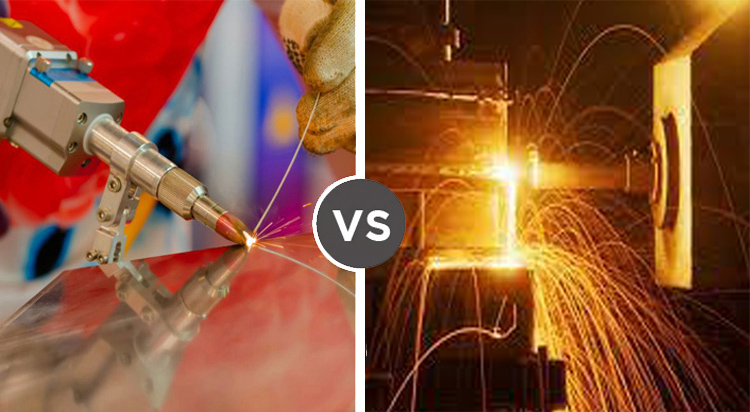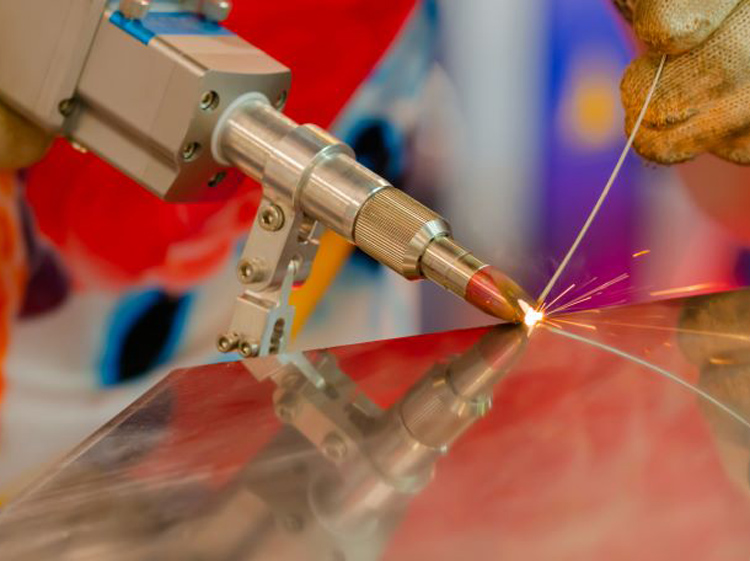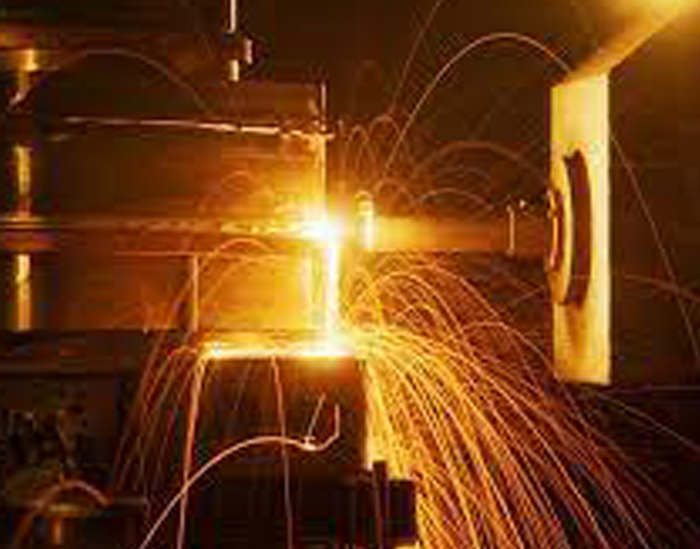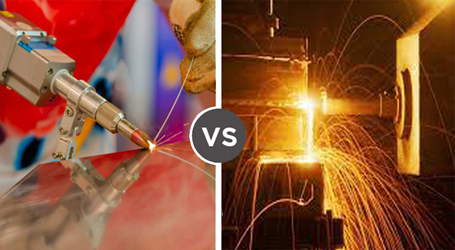When it comes to welding technologies, two of the most popular methods are electron beam welding and laser welding. While both of these methods have their merits, they also have some differences that set them apart from each other. Understanding these differences is crucial when determining which technology will be a better fit for your welding needs.
In this guide, we will provide a comprehensive comparison between electron beam welding vs laser welding. We will explore the key differences between the two processes, their advantages and limitations, and the various applications where they are commonly used. By the end of this guide, you will have a clear understanding of which technology is better suited for your welding needs.

What is Electron Beam Welding?
Electron beam welding is a highly precise welding technique that uses a beam of high-velocity electrons to join two metal parts together. The electrons are generated in a special vacuum chamber and accelerated to high speeds using an electromagnetic field. The beam is directed towards the welding area, where it melts and joins the metal parts together.
The advantages of electron beam welding are numerous. One major benefit is its ability to achieve deep and narrow welds, making it ideal for welding thick metal parts. It also has a high energy density, which means it can weld at high speeds and with minimal distortion. It can be used to weld a wide range of materials, including refractory metals and alloys.
The electron beam welding process involves a few key steps. First, the metal parts are cleaned and positioned precisely. Next, a special vacuum chamber is used to create a low-pressure environment where the electrons can travel freely. Once the chamber is ready, the electrons are generated and accelerated towards the welding area. The beam is then focused on the joint, melting the metal and creating a strong bond. The process is controlled by a computer system that ensures precision and accuracy.
Electron beam welding has many practical applications. It is commonly used in the aerospace industry, where it is used to weld turbine blades, rocket engines, and other critical components. It is also used in the medical industry to weld surgical instruments and implants. Additionally, it can be used in the automotive, electronics, and defense industries.
What is Laser Welding?
Laser welding has emerged as a popular alternative to traditional welding methods in recent years due to its precision, versatility, and speed. This process involves using a laser beam to melt the material being welded, creating a strong bond between the two pieces.
One of the major benefits of laser welding is its ability to produce high-quality welds with minimal thermal distortion. This is because the heat-affected zone (HAZ) is much smaller in laser welding compared to other methods, resulting in less distortion and warping. As a result, laser welding is often preferred for precision welding applications such as in the medical and aerospace industries.
The laser welding process is also highly versatile and can weld a variety of materials such as metals, plastics, and ceramics. With the use of specialized lasers such as pulsed laser systems, laser welding can also achieve high welding speeds, making it suitable for large-scale production processes.
Advantages of Laser Welding
- Precision welding with minimal thermal distortion
- Can weld a variety of materials
- High welding speeds
- Suitable for large-scale production
Despite its advantages, there are also some limitations associated with laser welding. One potential drawback is the need for adequate safety precautions due to the high-intensity laser beam used in the process. Furthermore, compared to other welding techniques, laser welding can be more expensive due to the cost of specialized equipment and maintenance. Additionally, weld depth can be limited in some cases, making it less suitable for thicker materials.
Laser Welding Applications
| Industry | Application |
|---|---|
| Automotive | Welding of engine components, body parts, and exhaust systems |
| Medical | Welding of medical devices with precision and cleanliness |
| Aerospace | Welding of critical components such as turbine blades and fuel nozzles |
| Electronics | Welding of miniature components and electronic circuits |
Overall, laser welding is a versatile and precise welding technique with a wide range of applications across various industries. The suitability of this process depends on factors such as material type, required precision, and production volume. By understanding the advantages and limitations of laser welding, you can make an informed decision on whether it is the right process for your project.

Photos by istockphoto.com
Key Differences between Electron Beam Welding vs Laser Welding
While electron beam welding vs laser welding both are precision welding technologies that can achieve highly accurate and repeatable welds, there are several key differences between these two techniques.
Power source: The primary difference between electron beam welding vs laser welding is the power source used for each technique. Electron beam welding uses a focused beam of high-energy electrons to melt and fuse metals, while laser welding uses a focused beam of light energy to melt metals.
Beam characteristics: Electron beam welding produces a high-speed beam of electrons that can achieve higher penetration depths. In contrast, laser welding produces a beam of light that is highly directional and has lower penetration depths compared to electron beam welding.
| Electron Beam Welding | Laser Welding |
|---|---|
| Uses a focused beam of high-energy electrons to melt and fuse metals | Uses a focused beam of light energy to melt metals |
| Produces a high-speed beam of electrons that can achieve higher penetration depths | Produces a beam of light that is highly directional and has lower penetration depths compared to electron beam welding |
| Requires a vacuum environment to operate | Can operate in an air or inert gas environment, making it more suitable for certain applications |
Welding speed: Laser welding typically has a faster welding speed compared to electron beam welding because of the higher beam density and more efficient heat transfer. Electron beam welding can achieve deeper welds in a single pass, which can offset the slower welding speed in certain applications.
Material suitability: Electron beam welding is typically more suitable for welding thicker materials because of its higher penetration capabilities, while laser welding is more suitable for welding thinner materials.
“The primary difference between electron beam welding and laser welding is the power source used for each technique.”
Understanding the key differences between electron beam welding vs laser welding is crucial in determining which welding technology is better suited for specific projects. While both techniques have their advantages and limitations, choosing the right welding method depends on the unique requirements of the project, material type, and cost-effectiveness.
Advantages of Electron Beam Welding
Electron beam welding (EBW) is a high-energy welding process that utilizes a focused beam of electrons to join materials. This innovative technique offers numerous advantages over traditional welding methods and is ideal for a wide range of industrial applications.
One of the main advantages of electron beam welding is its ability to produce deep and narrow welds. This is due to the high energy density of the electron beam, which allows for precise control of the weld depth and width. Electron Beam Welding (EBW) is a high-speed process, making it perfect for high-volume manufacturing applications.
Electron Beam Welding is also suitable for welding a variety of materials, including refractory metals, which are often difficult to weld using traditional techniques. The absence of filler material makes it possible to weld dissimilar materials with minimal risk of metallurgical defects.
Limitations of Electron Beam Welding
Like any welding technique, EBW has its limitations. One significant limitation of EBW is its high cost. The equipment required for electron beam welding is expensive, and the process can be time-consuming, which can add to the overall cost of the project.
Another limitation of Electron Beam Welding is its sensitivity to surface contamination. The presence of even small amounts of surface contaminants such as oil, grease, or oxide can cause significant welding defects. Proper cleaning and preparation of the welding surface are crucial for achieving successful welds with Electron Beam Welding.
Despite its limitations, electron beam welding remains a valuable technique for many industrial applications due to its ability to produce deep and narrow welds at high speeds and with high precision. If you require welds with these specific characteristics, EBW may be the ideal solution for your project.

Photos by westermans.com
Advantages of Laser Welding
Laser welding is a versatile process that offers several advantages over traditional welding techniques. One significant advantage of laser welding is its high precision. The laser beam can be finely focused on even the smallest of components, resulting in precise welds that require little to no finishing work. Laser welding can be completed at high speeds, making it an efficient choice for high-volume production runs.
Another advantage of laser welding is its suitability for a wide range of materials. Laser welding can be used to join both similar and dissimilar metals, as well as welding plastics and other materials. This versatility makes it an excellent choice for a variety of industries, from automotive and aerospace to electronics and medical.
Limitations of Laser Welding
Laser welding also has some limitations. One of the main drawbacks of laser welding is its potential to create heat-affected zones (HAZ) around the weld area. These HAZs can weaken the material, reducing its strength and durability. As such, laser welding may not be suitable for applications where the material needs to remain at maximum strength, such as in high-stress situations or extreme environments.
Another limitation of laser welding is its inability to penetrate deep into thick materials. While laser welding can provide precise, shallow welds, it may not be effective for applications that require deep or thicker joints. In such cases, alternative welding techniques, such as electron beam welding, may be more suitable.
Comparative Advantages and Limitations of Laser Welding and Electron Beam Welding
| Laser Welding | Electron Beam Welding | |
|---|---|---|
| Advantages | High precision | Deep penetration into thick materials |
| Wide material suitability | High energy density | |
| Fast welding speeds | ||
| Limitations | Heat-affected zones | Limited material suitability |
| Limited penetration into thick materials | Low welding speeds |
In summary, laser welding offers several advantages, such as high precision, fast welding speeds, and wide material suitability. However, it also has some limitations, including the potential to create heat-affected zones and limitations in penetrating deep into thick materials. When choosing between laser welding and other options, it’s important to consider your specific project requirements and select the process that best meets your needs.
Conclusion
After exploring the various aspects of electron beam welding and laser welding, it is clear that both techniques offer significant advantages and limitations. Choosing the best welding technology depends on several factors, including project requirements, material type, and cost-effectiveness.
In situations where precision and high-energy density are essential, electron beam welding may be the better choice. This technology can achieve deep and narrow welds, making it ideal for applications in aerospace and medical industries. The electron beam welding process requires vacuum conditions, which may increase costs and production time.
Laser welding, on the other hand, offers versatility and flexibility, making it suitable for various applications. It can weld a range of materials, including metals, plastics, and ceramics. Laser welding is also highly accurate, providing minimal heat-affected zones. The weld depth may be limited, and the process may not produce as much penetration as electron beam welding.
The decision on whether to use electron beam welding or laser welding depends on specific project requirements. While both methods have unique advantages, understanding the differences between them is important in making the proper choice.
FAQ
What is the difference between electron beam welding and laser welding?
Electron beam welding and laser welding are both effective welding techniques, but they differ in how they generate and deliver heat. Electron beam welding uses a high-energy electron beam, while laser welding uses a focused laser beam. The choice between the two methods depends on factors such as the material being welded, the desired weld depth and width, and the available equipment.
What are the advantages of electron beam welding?
Electron beam welding offers several advantages, including deep and narrow welds, high energy density, and minimal heat-affected zones. It is particularly suitable for welding materials with high melting points and can achieve precise and reliable welds.
What are the advantages of laser welding?
Laser welding provides versatility, precision, and fast welding speeds. It can weld a wide range of materials and is especially useful for creating intricate designs and joining dissimilar materials. Laser welding also offers non-contact processing, which minimizes the risk of contamination and distortion.
How do electron beam welding and laser welding compare in terms of welding speed?
Electron beam welding is generally faster than laser welding due to its higher power density. Laser welding offers the advantage of faster set-up times and increased flexibility in terms of beam manipulation and control.
What types of applications are suitable for electron beam welding?
Electron beam welding is commonly used in industries such as aerospace, automotive, medical, and electronics. It is suitable for welding thick sections, precision components, and materials with high melting points, such as titanium and nickel alloys.
What types of applications are suitable for laser welding?
Laser welding has a wide range of applications, including automotive manufacturing, jewelry making, and electronics. It is ideal for welding thin and delicate materials, as well as creating small, precise welds.
Are there any limitations to electron beam welding?
While electron beam welding offers numerous advantages, it also has some limitations. The process requires vacuum conditions, which can increase the complexity and cost of equipment. Additionally, electron beam welding may not be suitable for certain materials with low thermal conductivity or materials that are prone to cracking.
Are there any limitations to laser welding?
Laser welding can create heat-affected zones and may result in shallow weld penetration. It may also have limitations when welding materials with high reflectivity or those that are highly heat-sensitive. Advancements in laser technology have minimized these limitations in many cases.
